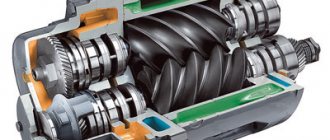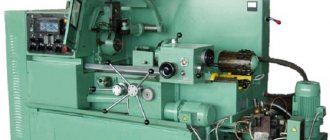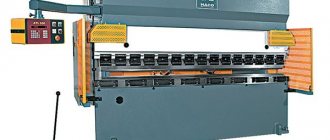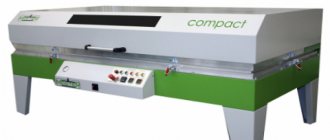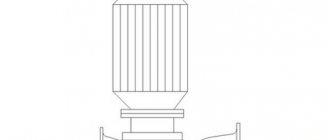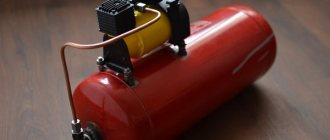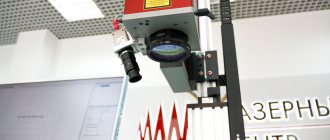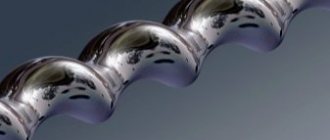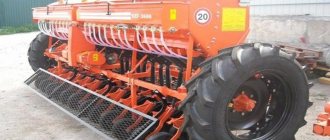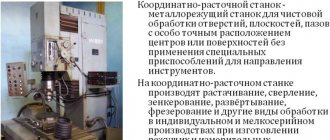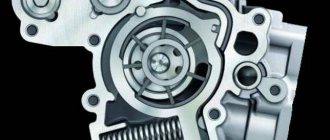The development of industrial technologies makes it easier to carry out work processes at all stages. In construction it is almost impossible to do without such an important tool as a jackhammer. Its main purpose is to destroy hard and durable structures and materials. With its help, the site is prepared for subsequent construction activities. A jackhammer is used to work with materials such as rocks, asphalt, concrete and reinforced concrete, as well as brick and various types of stone. In the household, the tool is used extremely rarely, because even if the need arises, it can easily be replaced by a hammer drill with a jackhammer function. That is why in this material we will consider where, when and for what the tool is used, what types there are, and which option is optimal for solving a specific type of problem.
What is a jackhammer: in what cases is it impossible to do without it?
A jackhammer is a specialized type of construction tool designed for breaking and loosening hard and durable materials. The device is not only large in size, but also heavy, which is why it is used exclusively for performing complex work. For example, it would not be rational to use it when it is necessary to remove the plaster layer in a house or remove ceramic tiles, since these types of tasks are considered to be an easy type of work, and a classic hammer drill can cope with them. It’s another matter when you need to destroy an old cinder block building, crush a concrete slab or destroy a concrete screed. In this case, you can do without heavy equipment, but you will not only have to put in a lot of effort, but also spend a lot of time.
It is impossible to do without the use of jackhammers in a number of the following cases:
- When dismantling of building structures is carried out: both complete and partial. A hammer drill is quite capable of crushing bricks, but crushing a concrete wall is a task for a jackhammer. In everyday life, there is a need to use a jackhammer when it is necessary to remove an unusable reinforced concrete slab or large boulder. This can be done with the help of special equipment, the calling of which will be very expensive. Using a chipper, you can crush a slab or boulder into small pieces, which ultimately makes it easier to subsequently dispose of the remaining parts.
- Removal of road surfaces from asphalt, concrete and reinforced concrete. Jackhammers are especially popular among workers who repair road surfaces. In the household, such a tool may be needed if it is necessary to destroy the concrete coating in the yard, which is planned to be replaced with paving slabs.
- Emergency rescue work.
- Tamping and compacting soil - in addition to destructive work, the tool is also used when preparing the floor for screed (compacting bulk materials), when installing reinforced concrete pillars and when preparing the area for pouring the foundation. The device is an alternative replacement for vibratory rammers.
- Knocking out window and door openings.
- Excavation of soil for subsequent pouring of the foundation.
- Loosening compacted or frozen soil and bulk building materials.
- Mining.
- Chasing walls for laying communications.
- Chiseling frozen ice.
Based on the presented work, the implementation of which is possible thanks to a jackhammer, you can draw an appropriate conclusion for yourself about the necessity and rationality of using the tool. Due to the fact that the devices have a wide range of applications, and are used not only at a professional level, they are available in two main versions. The first type is professional, characterized by such properties as:
- high performance and power, thanks to which the tool can be used to perform complex and heavy work;
- long service life, which is associated with high quality manufacturing of components;
- high cost, indicating not only the high-quality performance of the instrument, but also its great capabilities.
The second type of jackhammers are household ones, the purpose of which is to perform a certain range of work. For example, if there is a need to use a jackhammer around the house, you can either rent a professional tool or purchase a device and use it when the need arises. The cost of household tools is much lower than professional ones, which actually makes them more popular and in demand, especially among home craftsmen.
This is interesting! It is important to note that household appliances are distinguished not only by the average quality of their components, but also by their low weight. It is precisely due to the reduced weight of the tool that it cannot be used for all types of the above work.
General information about portable impact mechanisms
A jackhammer is a mechanical hand-held percussion tool designed for loosening hard and frozen soil, punching openings and openings in brick walls of buildings, dismantling brickwork, splitting ice, breaking coal of various strengths, extracting soft ores, clay, slate and other construction and mining materials. works
The executive body is usually a metal chisel or lance. The mechanization of a tool involves the impact on the executive body of a series of mechanical impulses from the striker, which is driven by some kind of drive. The impact frequency is 16…25 Hz. When a shock impulse is imparted to the chisel from the side of the striker part (butt plate), the cutting edge of the chisel acts on the material being processed, cutting it or splitting it.
A jackhammer is typically a valve-actuated piston impact machine. The hammer is turned on by pressing its handle with your hand. When the hammer operates, the striker performs a reciprocating movement and, at the end of the working stroke, strikes the shank of the lance, held in the axle box of the hammer barrel by an end spring. A worker uses a jackhammer as a lever when breaking rocks. The hammer turns off automatically when the force is removed from the handle.
The effectiveness of a jackhammer largely depends on the replaceable tip - the jackhammer lance. The lance directly affects the object being destroyed.
Being an intermediate link between the jackhammer striker and the object, the jackhammer peak should, on the one hand, effectively influence the object of destruction, and on the other hand, if possible, preserve the impact mechanism of the jackhammer. Those. A lance that is too “strong” will unnecessarily wear out the hammer, and a “soft” lance will be less effective in operation. Long-term practice shows that approximately ten peaks are consumed over the service life of one jackhammer.
For a jackhammer, there is a large selection of tips for the working body, which should be selected depending on the type of work planned, for example:
Figure 1 – Pick-chisel
The pick-chisel is used to cut through any material, to destroy brick walls, asphalt, frozen soil, granite. Lance lengths up to 1500 mm are available.
Figure 2 – Pick-crowbar
A tip in the form of a crowbar is chosen if you need to loosen the soil or destroy an asphalt or concrete surface.
And to combat icing, to cut down, crush and process the edges of asphalt, to strip walls of a layer of plaster, if you need to clear a large area of concrete, you will need a pick-shovel.
Figure 3 – Pick-scapula
The tamper is used to perform soil compaction work when it is necessary to seal a seam or a crack in a place where this cannot be done in the usual way.
Choosing the right jackhammer involves determining the purpose for which it is being purchased. It is the scope of application and operating conditions that determine the preferred characteristics of the tool. The main parameters are the number of beats per minute, the power and energy of the blow itself. The level of vibration and noise during operation is also important.
In addition, it is worth paying attention to the body and handle of the hammer, their ergonomics, functionality
Types of jackhammers by type of drive used
A jackhammer is such a popular type of tool that it is produced in various versions depending on the type of drive devices used. There are the following main types:
- Electric jackhammer - This is the most popular type of tool, which is almost indispensable on construction sites. An important limitation to its use is the high humidity of the room, which increases the likelihood of receiving an electric shock. The only important drawback of electric fenders is their connection to the electrical network.
- Gasoline jackhammer has found its active use among workers who carry out work to prepare the surface for laying road surfaces. The important advantages of such units are: mobility, that is, lack of connection to the electrical network, as well as increased drive power, which allows you to perform a wide range of heavy work: from crushing concrete structures to compacting soil.
- Hydraulic - a professional type of tool, the operating principle of which is based on the use of oil pressure. The devices are compact, which is due to the absence of drive units in their design, but at the same time they are tied to special hydraulic stations. If the cost of a hydraulic breaker is lower than the price of electric and gasoline ones, then the purchase of specialized stations is problematic even for construction organizations and companies. These types of fenders are used in rooms with high humidity, where there is a strict ban on the use of electrical devices.
- Pneumatic breaker - another most common version of tools, which has found active use not only among builders, but also road workers, miners, etc. The hammers are compact and easy to operate. Impact actions are created using a special compressor, to which the bump stop is connected via a high-pressure hose. The disadvantage is the attachment to the compressor, but the products are characterized by such advantages as low cost, high efficiency, long service life and low maintenance costs.
These are the main types of jackhammers that are produced by tool manufacturers. Among all the listed types, electric and pneumatic models are especially popular. Gasoline units are more expensive, so they are less in demand than previous types. Hydraulically driven tools are used only in specialized facilities.
According to the shape of the body
There is no need to talk much about the geometry of the body of construction jackhammers. Even in publications where their types are examined in detail, this topic is not covered. Everything is completely predictable: outwardly it is a rod with a tip of various shapes. But there are also externally similar riveting hammers that allow you to work effectively with large steel and aluminum rivets. The weight of such devices exceeds 3 kg, and they are quite bulky in size.
Air chipping hammers also deserve attention. They are helping:
- remove excess deposits on the surface of castings;
- clean parts of gating systems;
- clean out burnt marks.
What is the difference between a jackhammer and a hammer drill?
Quite rightly, many may have noticed the similarity of an electric jackhammer with such a popular construction tool as a hammer drill. Many novice craftsmen still confuse chippers with barrel perforators, which have an almost identical design. To learn how to distinguish a rotary hammer from a jackhammer, you need to know the following:
- A rotary hammer, unlike a jackhammer, is considered a universal tool that can replace an impact hammer and a drill. For this purpose, the devices are equipped with a special mode switch. The design of almost every rotary hammer has three modes: drilling, chiselling and impact drilling. The jackhammer is intended for chiselling purposes only and does not have any drilling capabilities.
- A distinctive feature of a jackhammer from a rotary hammer is its performance. If the hammer can be operated for 8-10 hours a day, then the hammer drill in impact mode is not recommended to be used for more than 15-25%. Often many craftsmen neglect this feature, which leads to a significant reduction in the service life of the hammer drill. It is important to take this into account when choosing between a hammer drill and a jackhammer.
- The dimensions of an electric jackhammer are much larger, so in everyday life such tools, unlike rotary hammers, are used less frequently.
- The magnitude of the impact force is less for rotary hammers than for jackhammers. For rotary hammers, the impact force does not exceed 20 J, which is typical for barrel-type tools. The jackhammer has an extended range of impact power, the value of which is above 40 J.
Many people choose hammer drills, justifying this by the fact that such a tool is universal and can replace not only a jackhammer, but also a drill. However, the choice should be made not according to the capabilities of the tool, but according to the type and type of work planned for execution (since the service life of the tool depends on this).
This is interesting! When choosing the right tool, experts recommend taking into account such factors as how often you plan to use the tool in shock mode, and what types of materials you plan to work with.
Electric jackhammer: design features and operating principle
Having learned how an electric jackhammer differs from a rotary hammer, you need to get acquainted with its structure in more detail. Electrical devices are based on powerful electric motors, due to which shock actions are created. However, the electric motor creates only rotational movements, and to convert such energy into impact, a gearbox and a mechanism called a striker are additionally used. Below is a diagram of the internal structure of an electric jackhammer.
Looking at a cross-section of an electric jackhammer, it is not difficult to understand the principle of its operation. The engine drives a shaft to which a connecting rod mechanism is attached, which is connected to the piston. The piston moves inside a sealed chamber. The driven piston (movement frequency is 33 strokes per second) creates high air pressure in the chamber, which acts on the cylindrical firing pin.
The striker acts on the striker, transferring impact energy to the nozzle, which is fixed in the tool chuck. The principle of operation of an electric jackhammer is quite simple, but when studying it, only one question arises - why do we need a sealed chamber in which air pressure is created? Thanks to the air pressure, the possibility of a negative impact on the crank mechanism, gearbox and engine of the tool is eliminated. The air pressure in the chamber acts not only as an impact force, but also as a smoothing element that absorbs the impact when the nozzle moves back.
This is a kind of buffer zone that not only performs the main work, but also protects the important structural mechanisms of the tool from their accelerated destruction. The video below provides a detailed description of the operating principle of an electric jackhammer.
Pneumatic jackhammers and features of their functioning
Such devices are distinguished by their simplicity of design, which affects not only their cost, but also their service life. The only drawback of pneumatic devices is that they are used in conjunction with compressors that operate on electricity. This means that you cannot use a pneumatic bumper where there is no centralized power supply, or only if there is an electric generator, but in this case, it is easier to purchase an electric tool. The operating principle of pneumatic jackhammers is even simpler than their electric and gasoline counterparts. To understand how it works, consider the diagram in the figure below.
The diagram shows important structural elements. The drive role is played by compressed air supplied from the compressor through a hose that is connected to the fitting. The operating principle of the tool is as follows:
- When the compressor starts, the tool operates in idle mode, that is, the working element number 5 does not perform impact actions.
- The transition to the working mode occurs after the operator picks up the tool and presses its working element (nozzle) into the material that needs to be crushed.
- This happens as follows: in idle mode, valve 9 in the diagram is pushed upward by air and does not allow it to pass to the working mechanism.
- When the master presses the handle, the valve closes and compressed air flows to the working mechanism.
- Initially, chamber 6 is filled with air, in which the piston with the striker is located. A zone of high pressure is created in it.
- A zone of low pressure is created under the piston, that is, air rarefaction occurs.
- The piston with the striker is directed downward (from excess pressure), acting on the back side of the nozzle installed in the tool chuck.
- The impact from the nozzle is transmitted to the object being processed, causing its destruction.
- The reverse movement of the nozzle occurs due to a change in the air supply channel. This is realized constructively using a special mechanism. There are 4 holes in the tool barrel, two of which are blind and two are through. The pins of the air distribution mechanism are installed in the blind holes, due to which air is alternately supplied to the corresponding channels of the tool.
- The pressure increases under the piston, and a vacuum occurs above it. Thus, an impact effect is created, in which the destructive effect of the processed material occurs.
The speed of the blows is approximately 25 to 30 blows per second, which corresponds to the value of electric tools. How a pneumatic jackhammer works inside can be seen in the video, which shows the process of disassembling the tool.
These types of tools have many different benefits. Some of the main advantages are:
- simplicity of design;
- high level of maintainability;
- infrequent occurrence of malfunctions;
- the absence of a drive reduces the weight of the tool;
- low cost;
- Possibility of use in rooms with high humidity and gas concentrations.
The disadvantage is not only the dependence on a compressor that is powered by electricity, but also the importance of using a blower with a large receiver. This is necessary in order to ensure a stable air supply.
This is interesting! If the farm has a high-performance compressor, then the best option for a jackhammer is a pneumatic one.
Kinds
Several parameters are used to classify the devices under consideration.
Based on performance, jackhammers are differentiated into three types.
- Lightweight options are designed for household work. They are capable of crushing plaster, tiles, etc., which makes them suitable for home repairs. The weight of such mini jackhammers is 5-6 kg.
- Medium power devices are suitable for asphalt, so they are used in some construction work. Weight from 6 to 10 kg provides the possibility of long-term horizontal holding.
- In industry and in the construction of buildings, high-power jackhammers weighing 15-30 kg are used.
However, mass is an indirect indicator of performance. There is a classification close to the above, based on other, more significant parameters. It also includes four types.
- The first includes jackhammers with impact energy up to 30 J and frequency up to 45 Hz. They are suitable for medium-strength materials such as asphalt, brick, clay, and work in confined spaces.
- The second type is represented by options with an impact energy of 40 J and a frequency of 34 Hz, used in general construction work.
- The third type includes models with impact energy up to 45 J and frequency up to 20 Hz. They are used for work with vertical impacts on durable materials.
- The fourth type is represented by hammers with an impact energy of more than 50 J and a frequency of up to 24 Hz. Such devices are used for high-strength materials.
Based on the power source, there are four types of jackhammers.
- Pneumatic devices are the most common type. The power source for them is a compressor. The principle of operation is based on the pressure of compressed air molecules on the chisel. This equipment is suitable for destroying any structures made of brick and concrete. For household options, a power of 5 J is required, while for industrial models this parameter ranges from 10 to 100 J. This is enough to destroy asphalt, stone, concrete, etc.
- Electric hammers are powered from the mains. The principle of their operation is to drive the striker through the rotational element of the electric motor. Performance parameters are up to 1700 W of power, 45 J of impact energy and 2000 beats per minute of frequency. Thus, these types of jackhammers have high impact power, but are not suitable for cutting and drilling materials.
- Gasoline devices are driven by an internal combustion engine, which does not have valves and a shaft. With low power, the main advantage of these options is autonomy, that is, the ability to be used anywhere. This is due to the absence of the need to connect to an energy source. The duration of operation is determined only by the amount of fuel. In addition, jackhammers of this type are considered safer in comparison with analogues. However, they have a high noise level. These models are used in the mining industry for the destruction of concrete, asphalt, and frozen soil.
- Hydraulic hammers use a variety of power sources. They are usually used in emergency rescue operations.
Pneumatic hammers are also divided into two types based on their operating principle.
- Volumetric devices are driven by rapidly expanding air in the chamber.
- The operation of turbine options is ensured by the energy generated by the rotation of the turbine.
The simplest classification of jackhammers based on a set of basic parameters differentiates them into professional and household.
Concrete breakers are distinguished by their large size, weight and productivity. These devices are designed for vertical and inclined work with concrete slabs, rocks, asphalt pavement, and frozen soils. Rotary hammers are usually more compact than jackhammers or similar in size, they are distinguished by greater accuracy and the ability to perform the functions of a drill and screwdriver with adjustable speed and reverse. This versatility makes them much better suited for household work. Thus, the operating instructions for PE-2520M indicate the possibility of its use as both a jackhammer and a drill.
Gasoline jackhammers and their varieties
The principle of operation of jackhammers, which are powered by internal combustion engines, is almost completely identical to electrical devices. Instead of an electric motor, an internal combustion engine is used to drive the piston. With its help, the air pressure acting on the firing pin increases in the chamber. The firing pin, in turn, hits the heel of the firing pin, transmitting a shock wave to the nozzle fixed in the tool chuck.
Gasoline jackhammers are classified into types according to the type of engine used. They come in two-stroke and four-stroke types. Jackhammers with two-stroke engines have such advantages as compact dimensions and low cost.
Design of a gasoline jackhammer
Units with four-stroke engines have a large reserve of power and performance. They weigh quite a lot, which allows them to be used not only for crushing material, but also for the purpose of compacting soil or bulk substances.
This is interesting! The main advantage of a jackhammer, which is powered by an internal combustion engine, is mobility. This eliminates the need to connect them to an electrical network or a compressor, as is typical for electric and pneumatic units.
Tool design features
A jackhammer is designed quite simply. The design of the unit is characterized by significant weight indicators. That is why, in most cases, the main material in the manufacture of a hammer is high-strength plastic.
The final component of the bump stop is the lance. Thanks to her, all the main work is carried out. Peaks are different. They are selected according to the type of work that needs to be performed. Peak types:
- pike-crowbar;
- chisel;
- spade-spade;
- tamper
One of the advantages of a jackhammer is the ability to operate it in absolutely any position. In addition, it can be used to easily deal with concrete and reinforced concrete. There are also special models of tools designed for use underwater.
Hydraulic jackhammer: operating principle and application advantages
Another type of jackhammer that should also be given attention is hydraulic. They are close relatives of pneumatic units, only instead of compressed air energy, they use oil pressure.
The principle of their operation is based on a distributor, through which the direction of the oil fluid supplied to the tool from the oil pump changes. Below is a diagram of the working principle of a hydraulic breaker.
The diagram shows that the main structural elements are a piston with a striker, as well as a plunger, which is responsible for the timely opening of the corresponding oil channels. In order not to delve into details, it is necessary to note the main stages of operation of hydraulic jackhammers:
- Oil is supplied under pressure into the chamber in which the piston is acted upon.
- The piston creates oil pressure in the adjacent chamber and acts on the striker, which impacts the nozzle fixed in the tool chuck.
- The reverse action of the nozzle is carried out by changing the direction of oil movement.
A more detailed operating principle of hydraulic jackhammers is presented in the video below.
The operating principle of hydraulic fenders is simple, which has a positive effect on the cost of the tool. An additional advantage is the absence of heating effect on internal parts, which increases their service life. Oil is not only a working material, but also a coolant, thanks to which the service life of such a tool increases tens of times.
The disadvantage of their use is the need to use an oil station. This equipment is expensive, so it is not rational to buy this type of tool for use in the household. Not many construction companies can afford to purchase such tools. Their main advantage is high performance and reliability, but in addition, the advantages of such tools include:
- Effective work for a long time without interruption.
- There is no possibility of power loss, since the tool parts are not exposed to heat and last a long time.
- High speed of dismantling work. Compared to pneumatic ones, hydraulic fenders do the job 2-3 times faster.
- Easy to use. To get started, you need to start the engine of the oil station and connect two hydraulic hoses to the fender.
- Compact equipment. The weight of the hammer is no more than 20 kg, and the weight of the station is up to 60 kg. This allows you to transport the equipment in a passenger car with a large luggage compartment.
If there is a need to perform a large amount of work, you can contact companies that provide hydraulic breakers for rent.
Main technical parameters of jackhammers
Having understood the types of fenders, you should pay attention to their technical parameters. After all, it is based on them that the appropriate tools are selected to perform the assigned tasks. Before we begin to consider the main technical parameters of the tools, it should be noted that it is recommended to select them according to such criteria as the weight of the device and the thickness of the material being processed. It will be extremely difficult to work with a chipper that weighs more than 10-15 kg in the vertical direction or above the head. And the second criterion is that the thicker the concrete slab, the more difficult it will be for a low-power device to cope with it. Using a powerful jackhammer, you can solve the task tens of times faster, while eliminating the operator’s physical fatigue.
Moving on to the study of the technical parameters of jackhammers, the following characteristics should be mentioned, which are inherent in tools of all types (gasoline, electric, pneumatic):
- Weight - according to this criterion, jackhammers are classified into three main types. They are light, medium and heavy, depending on their power. Tools weighing up to 6 kg belong to the household category, and are designed to impact not only thin-walled surfaces, but also to carry out work in the horizontal direction, as well as above head level, that is, at height. Medium power tools up to 10 kg are designed for vertical cultivation of surfaces. The most high-performance devices are units whose weight is over 15 kg, and can reach 30 kg or more. Tools weighing more than 30 kg are classified as industrial.
- Impact force is one of the most important parameters of a tool, which depends directly on its power. Jackhammers are available with impact force parameters from 2 to 63 J. The higher the indicator, the correspondingly greater the mass of the tool.
- Power - this parameter is indicated for electric and gasoline-type devices. The higher the power rating, the greater the performance and, accordingly, the impact force. For pneumatic and hydraulic type tools, values such as air flow and fluid flow are used. The higher the level of these values, the correspondingly higher their power and performance.
- Impact frequency - affects the speed of the tool. The higher the impact frequency, the higher the performance, but this parameter has a direct relationship with the impact force. The greater the weight and impact force of the jackhammer, the lower the frequency. For heavy and powerful instruments, the value can be about 1000 beats per minute, and for light ones about 3500. Impact frequency, although an important parameter, is not decisive.
Based on the impact force, jackhammers are divided into four main types. They must be selected based on the type of materials being processed:
- up to 30 J - suitable for removing and destroying materials with medium strength. They are distinguished by their compact dimensions and low weight, which allows them to be used in cramped conditions and at heights;
- up to 40 J - used for general construction work;
- up to 45 J - suitable for working with durable materials, and are used with the tool directed vertically downwards;
- up to 50 J - for working with materials of particularly high strength and large thickness.
Tools with high power and impact force are necessarily equipped with shock-absorbing mechanisms. Their purpose is to reduce the level of vibration transmitted to the user.
Manufacturers. Who to give preference to?
1. Makita jackhammer. This brand is in great demand in the building materials market because it has an excellent reputation. Each unit of production is characterized by Japanese precision, high quality, and practicality. The pricing policy is acceptable.
The Makita jackhammer is produced by the company in a wide range; in the model range you can find custom and professional, light, medium and heavy, as well as electric, pneumatic and gasoline chippers.
In the “Custom Jackhammer” group, I would like to highlight the Makita HK 0500 (HK0500) SDS-plus model. Its technical characteristics are amazing: weight - 3100 grams, length - 46.8 cm, while the impact force is 2.8 Joules, and the number of blows in 60 seconds is 2000-3500.
In the line of professional models, Makita HM 1203 C (HM1203C) SDS-MAX and Makita HM 1304 B (HM1304B) 28.6 mm deserve special attention. These models optimally combine parameters such as weight, force and impact frequency.
2. Bosch jackhammer. German quality has long been valued all over the world, and the quality characteristics of this category of products are no exception.
It is worth noting that this quality is expensive, but quickly pays off. One of the best professional hammers of this brand is the BOSCH GSH 27 model.
3. Jackhammer "Interskol". Produced on the territory of the Russian Federation. The model range includes many positions. The company demonstrates the ideal price-quality ratio of its products.
Varieties of types of cartridges and attachments for a jackhammer
Most household-type jackhammers are equipped with SDS-plus type quick-release chucks. The appearance of this type of shank is shown in the photo below.
For devices that have high power, nozzles that have an SDS-max type shank are used. The difference lies not only in the thickness of the tail section, but also in its design. If the SDS-plus attachment has two open and two closed grooves, then the equipment with the SDS-max type has three open grooves, which are designed to securely fix the working elements in the tool chuck. Below is the design of the SDS-max shank, and you can read more about them here.
A separate type of shank for a jackhammer is hexagonal. Below are bits with hexagonal shanks.
This is interesting! The selection of the appropriate type of attachment depends on the type of chuck used on the tool.
To be able to install attachments in the desired direction, which applies to chisels and shovels, the design of jackhammers includes a rotating mechanism (clutch). The photo below shows a diagram of its operation.
As with rotary hammers, corresponding types of attachments are available for jackhammers. They differ in the shape of the working part, so let’s look at their main types and purpose.
- A crowbar or peak is the most popular type of attachment for jackhammers, which are designed for dismantling brick, concrete and other materials. They are also used to loosen soil and remove road surfaces.
- The blade has a thickened working part with a characteristic sharpening. It is used for leveling asphalt edges, removing plaster, chipping walls and other tasks that require processing large surfaces.
- Chisel or chisel - used for cutting metal of different profiles, for example, reinforcement, which is found in reinforced concrete slabs.
- Wide blade - designed for working in hard ground, as well as removing tree and bush roots.
- A rammer is an attachment that is used to compact a surface using a jackhammer.
- A shovel with a triangular cutout of the working part is used for tamping ballast under the sleepers of railway tracks.
The choice of the appropriate type of nozzle must be approached responsibly. After all, they differ not only in the shape of the tips, but also in quality. The higher the power of the tool for which you plan to use the nozzle, the greater the strength of the metal from which it is made. Otherwise, the nozzle may quickly become dull and break.
Features of repair and maintenance of an electric jackhammer
Having studied the design and operating principle of jackhammers, it is worth saying a few words about their repair and maintenance. Although the tools are characterized by high reliability, no manufacturer can guarantee eternal operation. To increase the service life of the tool as a whole and its components, you should make it a rule to perform regular maintenance. Naturally, this must be done at a time when the tool is not in use.
The working units (electrical and mechanical parts) of the tool are most susceptible to wear. Let's look at the example of an electric jackhammer from DeWalt:
- If the tool does not start when you turn it on, then you should check the serviceability of the button, brushes (if a brush motor is used), and wires. To check these elements you will need to use a multimeter.
- If the efficiency or dynamics of destruction decreases, you should resort to checking the mechanical components. Most often, a decrease in performance is associated with a decrease in the pressure created inside the chamber. The situation can be corrected by replacing the rubber ring on the piston...
- And on the striker.
- We evaluate the condition of the piston, which should be free of chips, scuffs and other defects.
- The cartridge must be regularly disassembled and cleaned. This is done in order to eliminate the possibility of the nozzle jamming in the chuck, as well as to increase the service life of the component parts. How to disassemble the jackhammer cartridge and clean it is described in detail in the video below.
- Check the condition of the gears (gearbox). The teeth should be in place, and there should be no play in the shafts. If there is play, the bearings should be replaced. Remove old grease and apply new grease to the breaker gears.
The process of repairing a jackhammer depends on the type of malfunction. The design of the tool is not much more complicated than that of a rotary hammer, so you can diagnose and repair the breakdown yourself, without the help of specialists. However, it is important to note that when choosing Chinese-made tools, you will need to carry out repair work more often than when using bump stops from brands such as Bosch, DeWalt, Makita, Hilti and others.
To summarize, it should be noted that a jackhammer is not at all an indispensable tool in the household. A rotary hammer, which is multifunctional, is quite capable of replacing it. However, it is impossible to do without a jackhammer when performing construction work related to the dismantling of concrete slabs, reinforced concrete structures, brick walls, cinder blocks and other materials. In this case, it is necessary to select the optimal type of tool depending not only on the type, but also on the complexity of the planned work.
Criteria for choosing a hammer
The high energy content and the fairly large mass of individual devices force us to pay attention not only to the purely technical characteristics of jackhammers. Such non-obvious factors as ergonomics and layout are also assessed.
Impact energy
As mentioned above, it is not recommended to use jackhammers to destroy reinforced concrete or cement monoliths with a low sand content in the solution. Carrying out such work will not only lead to low productivity, but will also cause high wear and tear, and, consequently, the need to spend money on repairs.
You need to choose the optimal model according to the manufacturer’s recommendations. If you need to get a guaranteed result, it is recommended to explore thematic forums or ask for advice from experienced builders.
Weight and dimensions
Estimating the weight of a jackhammer and the size of the device is a highly individual process. The tool is selected based on habits, operating mode (time of activity - rest), and usual indicators of free space for manipulation. However, you should pay attention to the weight distribution of the device. The closer the center of gravity is to the leading hand, the less fatigue accumulates during the necessary movements of the tool .
Materials
All materials in the design of the device must be as strong and reliable as possible. The use of plastic is not allowed for gearbox elements. But some manufacturers don't know about this. Therefore, each product should be examined as carefully as possible before purchasing, so as not to encounter breakdowns literally in the first hour of operation. The main thing is that you should not skimp on tools from reliable brands.
Ergonomics
The design of the jackhammer should ensure zero deflection of the tool axis upon impact and ensure that it is held in the hand as rigidly as possible.
- The hammer handle should have a straight section at the grip point.
- The grip zone should be located on the axis of application of the impact impulse.
- If the tool has two handles (heavy ones, concrete breakers), they should be located on the same line, perpendicular to the axis of impact, with hand grips at an equal distance from the center.
Any handle has a start button. The location of this element must be such that pressing or switching does not require a loosening of the grip. The same applies to any regulatory bodies. None of them should cause the need to shift attention or change the mechanics of operating the instrument.
